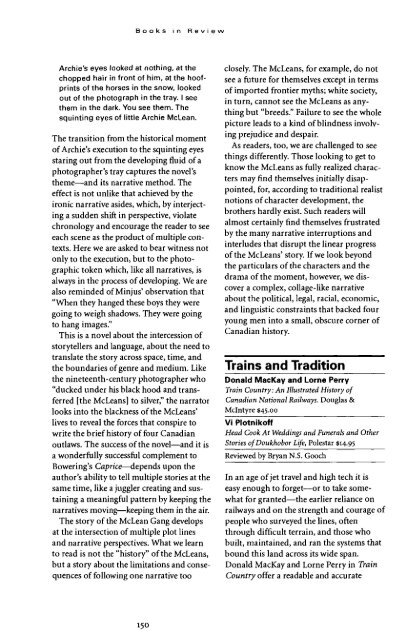Jean Rivard - University of British Columbia
Jean Rivard - University of British Columbia
Jean Rivard - University of British Columbia
You also want an ePaper? Increase the reach of your titles
YUMPU automatically turns print PDFs into web optimized ePapers that Google loves.
Books in Review<br />
Archie's eyes looked at nothing, at the<br />
chopped hair in front <strong>of</strong> him, at the ho<strong>of</strong>prints<br />
<strong>of</strong> the horses in the snow, looked<br />
out <strong>of</strong> the photograph in the tray. I see<br />
them in the dark. You see them. The<br />
squinting eyes <strong>of</strong> little Archie McLean.<br />
The transition from the historical moment<br />
<strong>of</strong> Archie's execution to the squinting eyes<br />
staring out from the developing fluid <strong>of</strong> a<br />
photographer's tray captures the novel's<br />
theme—and its narrative method. The<br />
effect is not unlike that achieved by the<br />
ironic narrative asides, which, by interjecting<br />
a sudden shift in perspective, violate<br />
chronology and encourage the reader to see<br />
each scene as the product <strong>of</strong> multiple contexts.<br />
Here we are asked to bear witness not<br />
only to the execution, but to the photographic<br />
token which, like all narratives, is<br />
always in the process <strong>of</strong> developing. We are<br />
also reminded <strong>of</strong> Minjus' observation that<br />
"When they hanged these boys they were<br />
going to weigh shadows. They were going<br />
to hang images."<br />
This is a novel about the intercession <strong>of</strong><br />
storytellers and language, about the need to<br />
translate the story across space, time, and<br />
the boundaries <strong>of</strong> genre and medium. Like<br />
the nineteenth-century photographer who<br />
"ducked under his black hood and transferred<br />
[the McLeans] to silver," the narrator<br />
looks into the blackness <strong>of</strong> the McLeans'<br />
lives to reveal the forces that conspire to<br />
write the brief history <strong>of</strong> four Canadian<br />
outlaws. The success <strong>of</strong> the novel—and it is<br />
a wonderfully successful complement to<br />
Bowering's Caprice—depends upon the<br />
author's ability to tell multiple stories at the<br />
same time, like a juggler creating and sustaining<br />
a meaningful pattern by keeping the<br />
narratives moving—keeping them in the air.<br />
The story <strong>of</strong> the McLean Gang develops<br />
at the intersection <strong>of</strong> multiple plot lines<br />
and narrative perspectives. What we learn<br />
to read is not the "history" <strong>of</strong> the McLeans,<br />
but a story about the limitations and consequences<br />
<strong>of</strong> following one narrative too<br />
closely. The McLeans, for example, do not<br />
see a future for themselves except in terms<br />
<strong>of</strong> imported frontier myths; white society,<br />
in turn, cannot see the McLeans as anything<br />
but "breeds." Failure to see the whole<br />
picture leads to a kind <strong>of</strong> blindness involving<br />
prejudice and despair.<br />
As readers, too, we are challenged to see<br />
things differently. Those looking to get to<br />
know the McLeans as fully realized characters<br />
may find themselves initially disappointed,<br />
for, according to traditional realist<br />
notions <strong>of</strong> character development, the<br />
brothers hardly exist. Such readers will<br />
almost certainly find themselves frustrated<br />
by the many narrative interruptions and<br />
interludes that disrupt the linear progress<br />
<strong>of</strong> the McLeans' story. If we look beyond<br />
the particulars <strong>of</strong> the characters and the<br />
drama <strong>of</strong> the moment, however, we discover<br />
a complex, collage-like narrative<br />
about the political, legal, racial, economic,<br />
and linguistic constraints that backed four<br />
young men into a small, obscure corner <strong>of</strong><br />
Canadian history.<br />
Trains and Tradition<br />
Donald MacKay and Lome Perry<br />
Train Country: An Illustrated History <strong>of</strong><br />
Canadian National Railways. Douglas &<br />
Mclntyre $45.00<br />
Vi Plotnik<strong>of</strong>f<br />
Head Cook At Weddings and Funerals and Other<br />
Stories <strong>of</strong>Doukhobor Life, Polestar $14.95<br />
Reviewed by Bryan N.S. Gooch<br />
In an age <strong>of</strong> jet travel and high tech it is<br />
easy enough to forget—or to take somewhat<br />
for granted—the earlier reliance on<br />
railways and on the strength and courage <strong>of</strong><br />
people who surveyed the lines, <strong>of</strong>ten<br />
through difficult terrain, and those who<br />
built, maintained, and ran the systems that<br />
bound this land across its wide span.<br />
Donald MacKay and Lome Perry in Train<br />
Country <strong>of</strong>fer a readable and accurate<br />
150

















